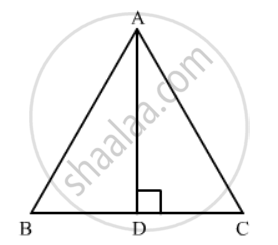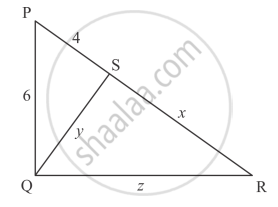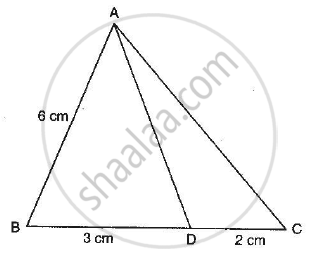Advertisements
Advertisements
Question
Prove that in an equilateral triangle, three times the square of a side is equal to four times the square of its altitudes.
Solution
Let ABC be an equilateral triangle and let `AD ⊥ BC`.

In Δ ADB and Δ ADC we have
`AB=AC`
`∠ B =∠ C`
And ` ∠ ADB = ∠ADC`
So , `BD =DC`
`⇒ BD =DC = 1/2 BC`
Since Δ ADB is a right triangle right-angled at D. So
`AB^2=AD^2+BD^2`
`AB^2=AD^2+(1/2BC)^2`
`AB^2=AD^2+(AB^2)/4`
`3/4 AB^2 =AD^2`
`3AB^2=4AD^2`
Hence proved.
APPEARS IN
RELATED QUESTIONS
In Figure below, if AB ⊥ BC, DC ⊥ BC and DE ⊥ AC, Prove that Δ CED ~ ABC.

In an isosceles ΔABC, the base AB is produced both the ways to P and Q such that AP × BQ = AC2. Prove that ΔAPC ~ ΔBCQ.
In ∆ABC, P and Q are points on sides AB and AC respectively such that PQ || BC. If AP = 4 cm, PB = 6 cm and PQ = 3 cm, determine BC.
In ∆ABC, P and Q are points on sides AB and AC respectively such that PQ || BC. If AP = 3 cm, PB = 5 cm and AC = 8 cm, find AQ.
In each of the figures given below, an altitude is drawn to the hypotenuse by a right-angled triangle. The length of different line-segment are marked in each figure. Determine x, y, z in each case.

In ∆ABC, given that AB = AC and BD ⊥ AC. Prove that BC2 = 2 AC. CD
In the adjoining figure, if AD is the bisector of ∠A, what is AC?

In the given figure, ∆AHK is similar to ∆ABC. If AK = 10 cm, BC = 3.5 cm and HK = 7 cm, find AC.

In triangles ABC and DEF, ∠A = ∠E = 40°, AB : ED = AC : EF and ∠F = 65°, then ∠B =
If ∆ABC is an equilateral triangle such that AD ⊥ BC, then AD2 =
